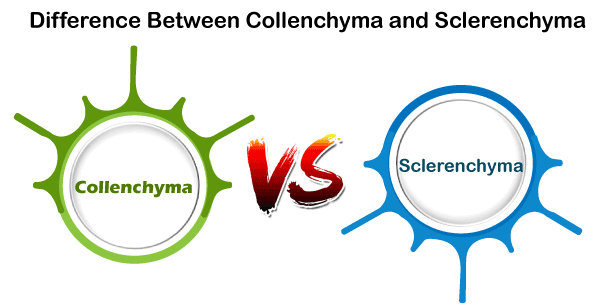Difference between Collenchyma and SclerenchymaBiology is a varied study of humans, animals, and plants. The systems due to which the human body, animals, and plants work are listed in biology. So, today we will be discussing about plants. Plants are one of the crucial creations on earth. Flora and fauna support millions of species in the world. Plants are a source of living for humans, animals, and various other species. Many birds have their home in these plants. Now, what are plants made of? Well, to be precise, plants are made up of tissues that strengthen them and provide them with food and water. Plants are able to survive because of such tissues. Two of these tissues are collenchyma and sclerenchyma. Let us discuss them in detail. 
CollenchymaCollenchyma is defined as a tissue that supports the plant in its growth. Collenchyma is responsible for protecting and ensuring the long life of the cells present in plants. These cells are protected by thick primary walls. The collenchyma is found in leaf veins, young stems, and petioles. Collenchyma is also responsible for carrying out the function of storing food and photosynthesis. This supporting tissue comprises of cellulose, hemicellulose, etc. Since it is a supporting tissue, it ensures and supports the plant structure, strength, and flexibility. For instance, when we bend small shoots of plants, they do not break because of the collenchyma present in them. The main function of collenchyma is to support the growth of a plant and ensure its long life. The cell walls present in collenchyma are irregular and thick. SclerenchymaSclerenchyma is also a supporting tissue. These are dead narrow cells located in the cell walls. Sclerenchyma is found in the outer layer of leaves and stems. This tissue makes the plant stiff and hard. This supporting tissue has lignin, and cell walls are relatively thick. The shape, structure, and size of sclerenchyma differ from each other. The major function of sclerenchyma is to protect the plant and provide support so that it is not damaged. Sclerenchyma is of two types, i.e., fibers (used for providing mechanical support to the plants) and sclereids (irregular branch-shaped structures). Unlike collenchyma, sclerenchyma has secondary walls. Now, you must be wondering, what is the difference between collenchyma and sclerenchyma. Well, the difference between them is given below.
So, these are some of the differences regarding collenchyma and sclerenchyma. It is interesting to note that both are the supporting tissues, but the functions they perform are different. These two are the significant kinds of plant tissues. Now, both collenchyma and sclerenchyma perform certain functions. So, let us take a look at them. Functions of Collenchyma
Functions of Sclerenchyma
So, these are some functions performed by the collenchyma and sclerenchyma. Now, there are several types of collenchyma and sclerenchyma. So, let us discuss the significant kinds of collenchyma and sclerenchyma. Types of Collenchyma
Types of Sclerenchyma:
So, these are the significant kinds of collenchyma and sclerenchyma. Both of them perform different functions, but both have one point of similarity, i.e., both ensure the protection and growth of the plant. Both are responsible for strengthening the plant internally as well as externally. Thus, collenchyma and sclerenchyma are the most important parts of the plants.
Next TopicDifference Between
|
 For Videos Join Our Youtube Channel: Join Now
For Videos Join Our Youtube Channel: Join Now
Feedback
- Send your Feedback to [email protected]
Help Others, Please Share










